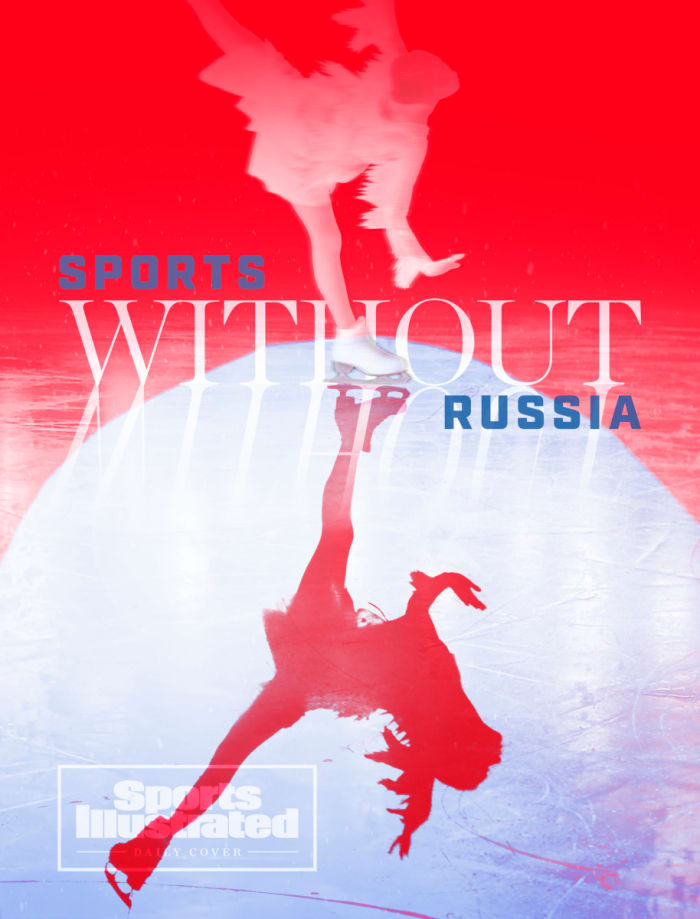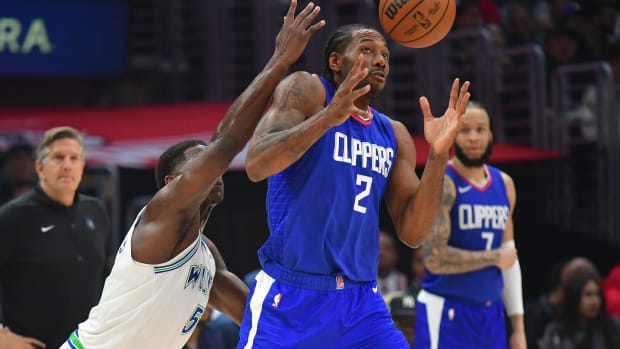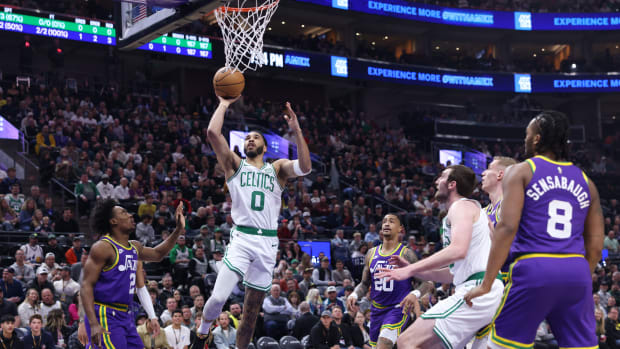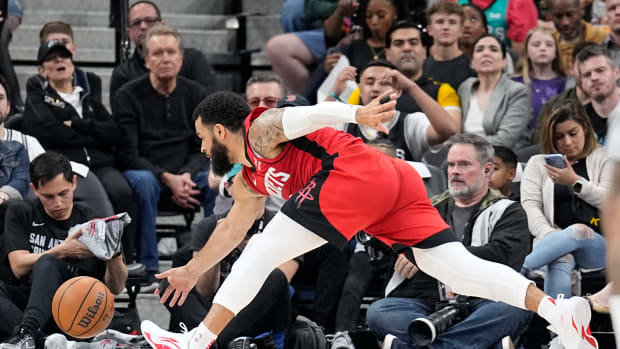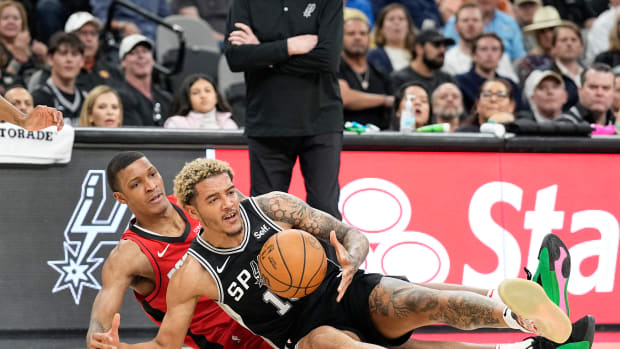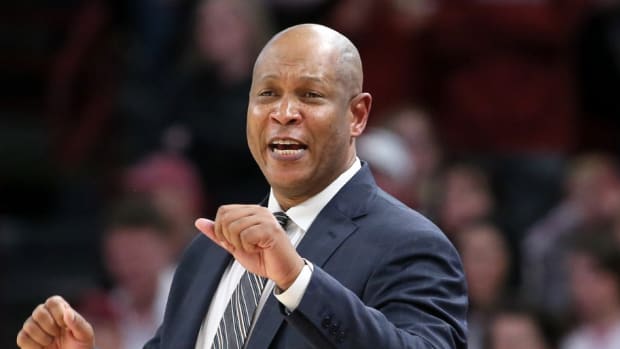SI:AM | Kyrie’s Return to Brooklyn Appears Imminent
Good morning, I’m Dan Gartland. Let’s look at how New York’s adjusted vaccine mandate will impact sports.
If you’re reading this on SI.com, you can sign up to get this free newsletter in your inbox each weekday at SI.com/newsletters.
There are baseball implications, too
New York mayor Eric Adams is expected to announce today adjustments to the city’s vaccine mandate for private employers that will allow for unvaccinated athletes to play home games in the city, according to multiple reports.
That mandate has kept Nets star Kyrie Irving from playing games at Brooklyn’s Barclays Center and Madison Square Garden in Manhattan. It also would have prevented unvaccinated Yankees and Mets players from playing home games when their seasons begin early next month.
Here are the details, according to the New York Daily News:
- The mandate will be lifted by April 7 (when the Yankees open the season at home against the Red Sox)
- Adams will make the announcement today at Citi Field in Queens
- Athletes and other performers at Yankee Stadium, Citi Field, Madison Square Garden and Barclays Center will be exempt
- The mandate will remain in place for all other businesses
New York City dropped its vaccine mandate for restaurants and other indoor venues earlier this month, allowing Irving to make a statement by showing up to watch his team in a game he wasn’t allowed to play in.
Adams was placed in a difficult position. He inherited the mandate from his predecessor, Bill de Blasio, who implemented it in December shortly before leaving office. Thousands of New Yorkers had lost their jobs for refusing to comply with the mandate, but accountants and cashiers and cooks don’t have their vaccination status discussed endlessly on national sports talk shows. Those people should have just gotten the shot, obviously, but they’re also right to be outraged that the mayor caved to public pressure and gave some people a pass just because they’re famous.
But let’s get back to sports. With Kyrie available for every postseason game, the Nets are a serious title contender. He had 43 points in Brooklyn’s 132–120 loss to the Grizzlies last night, continuing his offensive hot streak (he’s averaging 36.5 points per game over his last eight, dating back to Feb. 10). The move will also be big for the city’s baseball teams. Yankees sluggers Aaron Judge and Anthony Rizzo are believed to be unvaccinated (we’ll find out for sure when the Yankees travel to Toronto in early May, because Canada bars unvaccinated visitors), and the Mets failed to meet MLB’s 85% vaccination threshold for easing COVID-19 restrictions last season.
The easy, uncontroversial thing to do would be for every athlete in the city to just get the vaccine, but the new mayor potentially torpedoing his popularity by making an arbitrary exemption for a handful of millionaires also works.
The best of Sports Illustrated
Jon Wertheim checks in from the World Figure Skating Championships in Montpelier, France, in today’s Daily Cover to explore the world of sports without Russia:
“In Montpellier, Russia’s absence was not of the glaring variety. If the roster of skaters was altogether different from the slate in Beijing—often the case for this event in the years with Olympics; fresh off his singles gold, American Nathan Chen, for instance, begged off citing a ‘nagging injury’—the crowds filing into Sud de France Arena did not much seem to mind. Notwithstanding a clot of fans brandishing blue-and-gold nail polish and temporary tattoos, there was little indication that a war was raging 2,800 miles to the northeast.”
Conor Orr writes that the Dolphins’ acquisition of Tyreek Hill is the latest example of the NFL’s Madden era of roster-building strategy. … Ben Pickman and Emma Baccellieri rank the 16 teams remaining in the women’s tournament. … Former SI reporter Jenny Vrentas appeared on the latest episode of SI Weekly to discuss her reporting on sexual misconduct allegations against Deshaun Watson. … Here are Kevin Hanson’s top receivers in the 2022 NFL draft.
Around the Sports World
The U.S. State Department says Brittney Griner is in “good condition” in Russia after an embassy official was allowed to meet with her. … Ash Barty elaborated on her decision to retire at the top of her game. … The NHL voided a trade between the Ducks and Golden Knights because neither team was aware that a player involved had a limited no-trade clause. … Yankees minor league manager Rachel Balkovec, the first woman to manage an MLB-affiliated team, will have to wait to make her debut after she was struck in the face by a batted ball.
The top five...
… must-see moments from last night:
5. Damian Jones’s game-winning putback for the Kings
4. Devin Booker’s dunk over DeAngelo Russell (and the ensuing staredown)
3. Pierre Engvall’s toe-drag goal for the Maple Leafs against the Devils
2. Donovan Sims’s last-second three to force a second overtime in the CBI championship game
1. Jimmy Butler and Erik Spoelstra’s argument on the Heat sideline
SIQ
The longest game in NHL history was played on this day in 1936. The Red Wings defeated the Montreal Maroons in six (10-minute) overtimes in a game that took a total of 116 minutes and 30 seconds. What was the final score?
- 1–0
- 2–1
- 4–3
- 6–5
Check tomorrow’s newsletter for the answer.
Yesterday’s SIQ: Where did the Giants play while Yankee Stadium was being renovated in the 1970s?
Answer: The Yale Bowl. Giants Stadium was still under construction in New Jersey, so the Giants moved 70 miles up I-95 to New Haven, Conn.
Renovations began in the fall of 1973, after the Yankees’ season was over. So the Giants were able to play their first two home games in the Bronx before packing up for Connecticut. They played their entire home schedule in ’74 at the Yale Bowl (the nation’s first bowl-shaped stadium and the inspiration for future venues such as the Rose Bowl).
There were a few things about the move that made sense. The Yale Bowl had more seats (70,000) than Yankee Stadium did (65,000), making it a more desirable option than smaller nearby college stadiums at Princeton and West Point. And the Giants had been playing preseason games in New Haven since 1940 and annually since ’60.
Yale was not eager to welcome the Giants, though. According to a 1973 New York Times article, the school was wary of the effect bringing NFL football to New Haven would have on attendance at Yale games, which was already in sharp decline. The Giants also had reservations about moving so far away, unsure how many fans, especially those from New Jersey (who made up about 20% of Giants season-ticket holders at Yankee Stadium, according to the Times), would want to make such a long trip when they could just watch the game on TV.
The New Haven move ended up being a disaster. The Giants won just a single game there (24–13 over the St. Louis Cardinals on Nov. 18, 1973) and season-ticket sales plummeted. The team had previously sold 58,000 season tickets—the most in sports, according to the Times—but sold just 41,000 in New Haven. Giants players didn’t like the stadium’s antiquated feel and the long travel that turned home games into road games, according to the New Haven Register. In ’75, the Giants struck a deal to play their home games at Shea Stadium while waiting for the Meadowlands stadium to be completed. “I look at it as just a bleak period in our history,” Giants co-owner John Mara, who was a student at Boston College during the team’s Yale Bowl era, told Newsday in 2018. “Our team wasn’t very good. Our organization wasn’t very good. It would take us a number of years before we righted the ship. It was a very tough period to go through. So many defeats. So many embarrassing Sundays. It was just a bleak period, one that I try to block out.”
From the Vault: March 24, 1975
This photo of boxer Chuck Wepner has stuck with me ever since I first saw it a few weeks ago. The harshly lit closeup of his rugged face covered in beads of sweat looks like the poster for a horror movie. It isn’t your typical SI cover, depicting a person smiling for a portrait or with their impressive athleticism on display. It’s a sweaty guy with greasy hair staring disconcertingly past the camera.
And there’s a reason for that. Mark Kram’s cover story opens by talking about Wepner’s face. You see, Wepner had taken his fair share of punishment in his 11 years of professional boxing before landing a title fight against Muhammad Ali in 1975. He was known as the Bayonne Bleeder (after his hometown in New Jersey and propensity toward being busted open). Kram wrote that Wepner had received “well over 300 stitches” as the result of the beating taken in 41 fights. “After his 1970 loss to Sonny Liston, Wepner received 120 stitches, and it took the doctor four hours to put his face back together,” Kram wrote.
The Wepner fight was Ali’s 48th as a pro, but his face wasn’t as heavily repaired as Wepner’s—not by a long shot.
“Contrast the contours, the texture of Wepner’s face to Ali’s, which is smooth, unmarked, a testament to magic in the ring,” Kram wrote. “To most critics, Ali’s face alone (forget his hands) provides indisputable evidence to the outcome of what they consider to be only a footnote in heavyweight history.”
That wasn’t the only difference between Ali and Wepner. While Ali had been an Olympic champion and quickly achieved notoriety as a pro, Wepner fought mostly for modest purses in small venues near his hometown and still had a day job. He took a seven-week leave of absence from his job as a liquor salesman to train for the fight against Ali, for which he was paid $100,000 ($538,000 today) and Ali was paid $1.5 million ($8 million today).
It may have seemed like a mismatch, but Wepner went toe-to-toe with the champ, lasting 15 rounds. He even knocked Ali down in the ninth round. But Ali dropped Wepner with a series of blows to the head in the 15th round, ultimately sending him crashing into the ropes, at which point he was counted out by the referee.
Wepner’s performance was an inspiration, though. Before the fight, everyone was joking about how long this schlub from New Jersey could last against the great Ali. After he stepped between the ropes, he became a fan favorite. The sight of Wepner knocking down Ali made an impact on Sylvester Stallone, who recalled the moment in a 2018 interview with GQ:
“It was like a bolt of lightning from some Greek god in the sky, and, almost instantly, Wepner became the crowd favorite—in a matter of seconds. Suddenly, he went from being a complete joke to being somebody whom everybody watching could identify with—because everybody’s thinking, ‘Yes, I’d like to do that! I’d like to do the impossible, even if only for a moment, and be recognized for it—and have the crowd cheer.’ So it made everyone think to himself, ‘If this totally inept guy can put down Muhammad Ali, who knows what I can do.’ So I’m sitting there watching all this, and at some point I realize that the whole thing’s a metaphor, and I realized that it wasn’t really about boxing. Actually, Rocky was never really about boxing, it was about personal triumph.”
Wepner, who retired from boxing in 1978, was also profiled by Michael Farber in SI’s 2003 “Where Are They Now?” issue. At that point, Wepner was still working for the same liquor distributor that gave him the time off to face Ali. In addition to inspiring the Rocky franchise, Wepner’s story was told in the ’16 film Chuck and ’19’s The Brawler. He’s still alive today at 83.
Check out more of SI’s archives and historic images at vault.si.com.






























